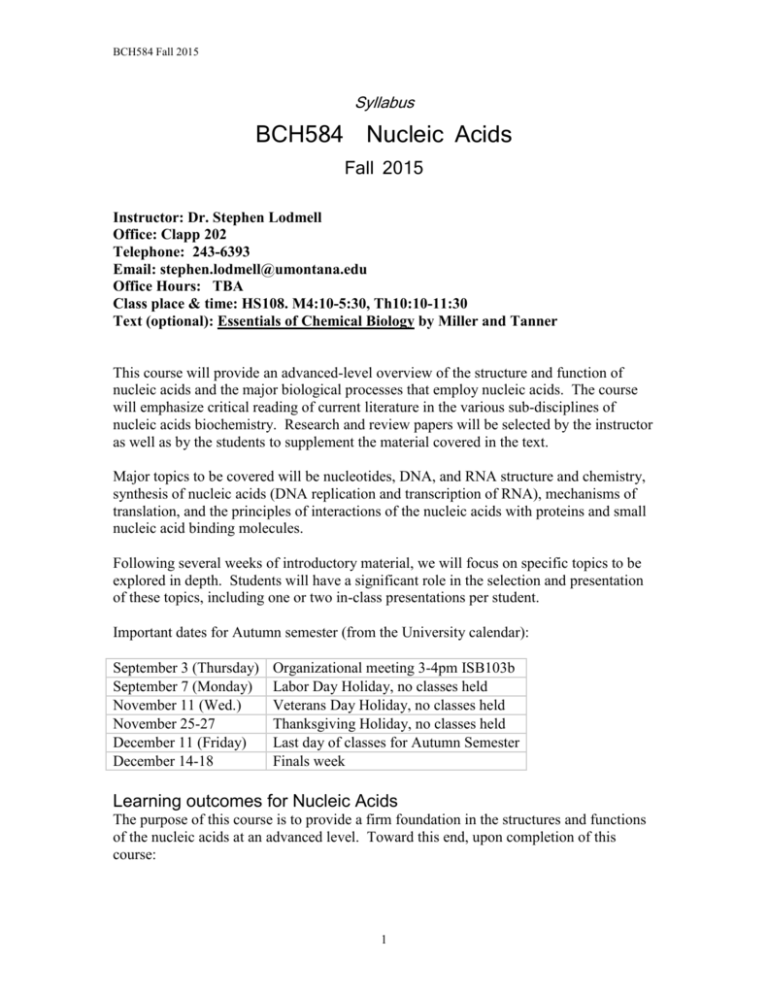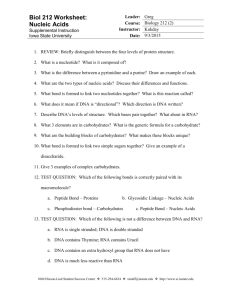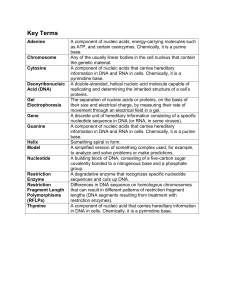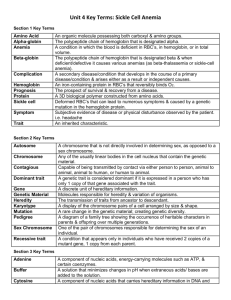Nucleic Acids
advertisement

BCH584 Fall 2015 BCH584 Syllabus Nucleic Acids Fall 2015 Instructor: Dr. Stephen Lodmell Office: Clapp 202 Telephone: 243-6393 Email: stephen.lodmell@umontana.edu Office Hours: TBA Class place & time: HS108. M4:10-5:30, Th10:10-11:30 Text (optional): Essentials of Chemical Biology by Miller and Tanner This course will provide an advanced-level overview of the structure and function of nucleic acids and the major biological processes that employ nucleic acids. The course will emphasize critical reading of current literature in the various sub-disciplines of nucleic acids biochemistry. Research and review papers will be selected by the instructor as well as by the students to supplement the material covered in the text. Major topics to be covered will be nucleotides, DNA, and RNA structure and chemistry, synthesis of nucleic acids (DNA replication and transcription of RNA), mechanisms of translation, and the principles of interactions of the nucleic acids with proteins and small nucleic acid binding molecules. Following several weeks of introductory material, we will focus on specific topics to be explored in depth. Students will have a significant role in the selection and presentation of these topics, including one or two in-class presentations per student. Important dates for Autumn semester (from the University calendar): September 3 (Thursday) September 7 (Monday) November 11 (Wed.) November 25-27 December 11 (Friday) December 14-18 Organizational meeting 3-4pm ISB103b Labor Day Holiday, no classes held Veterans Day Holiday, no classes held Thanksgiving Holiday, no classes held Last day of classes for Autumn Semester Finals week Learning outcomes for Nucleic Acids The purpose of this course is to provide a firm foundation in the structures and functions of the nucleic acids at an advanced level. Toward this end, upon completion of this course: 1 BCH584 Fall 2015 1. Students will understand nucleotide/nucleoside structure, properties, chemistry and functions. 2. Students will understand DNA and RNA structure. 3. Students will understand prokaryotic and eukaryotic DNA replication mechanisms. 4. Students will understand prokaryotic and eukaryotic RNA transcription mechanisms.. 5. Students will understand prokaryotic and eukaryotic translation (protein synthesis) mechanisms. 6. Students will become expert at topics of their choice related to nucleic acids, and will present the topic to the class. 7. Students will gain experience writing an NIH-style research proposal related to their special topic of choice. Possible topics for in-depth study: Nucleic acid structure modeling/ structure prediction Nucleotides as signaling molecules DNA damage and repair Protein interactions with Nucleic Acids Recognition of DNA sequences by nucleases, transcription factors, DNA repair molecules, viral RNA or DNA interactions with host or viral proteins, etc. Binding motifs of RNA/protein ligand pairs (r-proteins, helicases, synthetases, etc.) RNA (or DNA) mediated catalysis Natural (self splicing, RNase P) "new" biochemically-evolved activities Small non-coding RNAs (microRNAs: control of gene expression, RNA processing, and development) Unusual nucleic acids, e.g. locked nucleic acids (LNAs), spherical nucleic acids (SNAs) Origins of Life/ the RNA world RNA interference Telomere structure and function in chromosome maintenance, cancer, and aging Chromatin structure and the control of gene expression (DNA looping, topoisomerases, etc) Ribosome structure and function Translational control- riboswitches, siRNAs, miRNAs 2 BCH584 Fall 2015 Grading: 1. 2. 3. 4. 5. Midterm examination 25% Final examination (take home) 25% Oral presentation(s) 20% Class participation, assignments, quizzes, and written analyses of papers 10% Research proposal 20% The midterm examination will be a two-hour closed-book exam covering material from the first half of the semester. The final examination will include topics covered in class over the semester as well as related topics that will require some further research. The oral presentation(s) (one or two, depending on class size) will cover a topic agreed upon by the student and instructor and will complement the subject material in the course outline. The presentation will consist of a critical review of two related original research papers (see specific instructions) and will involve class discussion during and after the presentation. The accompanying written assignment will be in the form of a research proposal of 7 pages maximum (see specific instructions). While the research proposal does not necessarily have to pertain exactly to the oral presentation, it is assumed that the background research done for the oral presentation could be put to good use here as well. Active class participation is essential to the development of skills for critical analysis of scientific information, and is essential to the success of this type of course. Reading the assigned articles before class is mandatory and will be judged by class participation and/or the completion of assignments requiring careful reading of the assigned articles prior to class. 3 BCH584 Fall 2015 General University policies concerning written assignments: In working through homework assignments, students are encouraged to work together to solve problems, to share information or resources, and to test each other’s understanding of the material. Those are all acceptable forms of collaboration. However, the written work that each student turns in must be his or her own. Only in this way can faculty judge individual understanding of concepts or information. A good rule of thumb for students to follow is to work together up to the point of committing words to paper. At that stage, each student must work independently. A second key guideline is that once a student has written an out-of-class assignment, it must not be shown to another student in the course. Assignments from two or more students that have significant overlap, in the professional judgment of the faculty member, will be regarded as reflecting a violation of the expectation that students turn in independent assignments. Please note that direct copying of sentences from any published without proper citation is considered plagiarism. THIS INCLUDES THE INTERNET. Be sure to put the information in your own words and be aware that the instructor will check literary and Internet resources. Violations will be dealt with according to the Student Conduct Code. 4 BCH584 Fall 2015 Guidelines for the Oral Presentation BCH 584, Fall 2015 The presentation should be regarded more as a workshop than a formal seminar, as participation of the audience is essential. The oral presentation plus discussion will last 60 to 75 minutes and should be divided into the following general sections: 1. Introduction. A brief overview of the subject matter should be presented with enough background information to set the stage for the body of the talk. The introduction may be based upon as many research or review articles as the presenter deems necessary, but this portion of the talk will be limited to 10-15 minutes maximum. 2. Presentation and discussion of two related research articles. This is the body of the talk and should last approximately 45 minutes. Experimental data from both papers will be carefully analyzed with respect to the purpose of the experiment, the specific results obtained, the authors' interpretation of the data, and other possible interpretations of the individual or collective data sets. 3. Model, conclusions, and prospects. In the last 10-15 minutes of the talk, the presenter will summarize with an integrated model of the system, or discuss the relative features of two or more competing models from different laboratories. In addition, the presenter will suggest experiments that could be done to help advance the field. Your synthesis of the information, development of models and new hypotheses, and vision for further research in the field will be a primary determinant of your score on the presentation. Remember that interactive discussion between presenter and audience at this point could benefit the presenter in the preparation of the written research proposal (see guidelines below). Involve your audience and invite participation! Timetable for oral presentations: 2-4 weeks prior to talk. Arrange to meet with me outside class time about your talk. Bring a detailed outline of your talk, including a list of 5-10 papers that you feel best embody the current state of progress in the field and copies of the two papers that you plan to present. I will work with you on the organization of the talk or problems you may have encountered, if any. One week prior to talk. I will distribute copies of your papers to all class members. Your talk should be in near-final form. Each student is expected to have carefully read these articles before coming to class, and should be prepared to discuss the papers. It is recommended that class members write down questions and comments about the papers before coming to class. If class participation is inadequate for active critical analysis of the research, written analyses of the papers will be routinely collected from class members prior to each presentation. 5 BCH584 Fall 2015 Guidelines for the Written Research Proposal The major written assignment will be in the form of a research proposal and should probably originate from the research you did for your talk. In the research proposal, you may incorporate some aspects of the oral presentation, including some input you may have received from the class during discussion of your papers, but it should be written in a formal research proposal style. The size of this proposal (not including references) will be strictly limited in size to 7 single-spaced pages (with font size no smaller than 11 point and "normal" margins), so you must be concise. Focus your proposal carefully. As a general guideline, you should aim to resolve a scientific problem within two years, using about two laboratory workers. Don’t be too ambitious, or the proposal will not appear feasible to your reviewers. If you need help at any point during the preparation of your proposal, arrange to meet with me. Proposals can take lots of time to prepare, so start working on it early. Organize your proposal as follows: 1. Abstract. On a separate page write one paragraph of no more than 200 words that describes in general terms the problem, the approach, and the rationale -- why is it important to do this research? This page does not count toward the 7 page limit. 2. Specific Aims. State concisely what you plan to do, with the assumption that the reader is somewhat experienced in the field. The Specific Aims should be numbered so that they can be referred to in the rest of the proposal. The Specific Aims section should be self-contained and on exactly one page. 3. Background and Significance. The background and significance provides the setting for the problem that you plan to address. It is not necessary to review and cite all of the literature in the field, only the research that has been done that will help the reader to understand the problem and why you need to study it. But, be careful to cite all the literature that is crucial for the evaluation of your ideas. For example, if there are conflicting models, or if there is a research paper out that addressed a similar problem but that you do not believe, you must cite these and explain your position rather than ignore them. A proposal reviewer that realizes that you have not cited all potentially relevant research could conclude that you have not done your homework and the proposal may be fatally flawed. 4. Preliminary results. In this section, you can give details of some specific experiments that lead up to your proposed experiments. In a 'real' proposal, these would be details of experiments you (or a collaborator) have performed, which may or may not be published. In the present case, you will use published experiments that you feel are the most immediately relevant to your proposed experiments. 5. Experimental design. Explain carefully how you plan to address each of the Specific Aims. You must include enough detail to convince the reader that you know how to use the proposed technology. Discuss what you hope to learn with each 6 BCH584 Fall 2015 experiment, and what difficulties you may experience, either technically with the experimental procedure, or with the interpretation of results. Figures are helpful, but figures and text cannot exceed 7 pages. A bibliography of literature cited in the text should be added after the Experimental Design section and does not count in the page limit. Use full citations including titles of papers. This is a model research grant proposal, and as such, it should be free of typographical errors, spelling mistakes and grammatical errors. Proofread your proposal carefully, and ask a friend or colleague to read it as well. With the level of competition for grants today, reviewers need reasons to fault a proposal; a sloppily assembled application makes an easy target for rejection! Good luck and good research! 7






